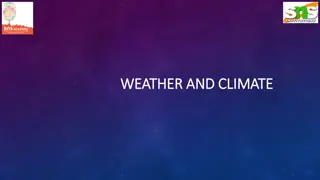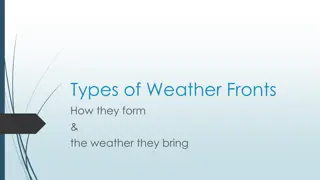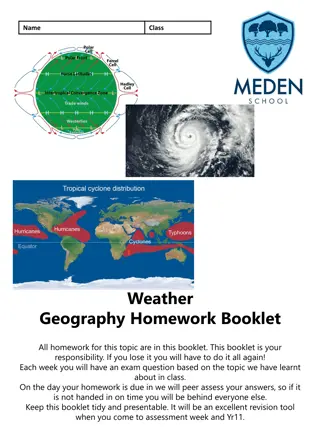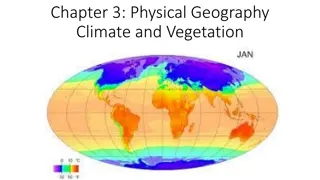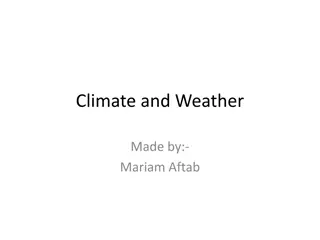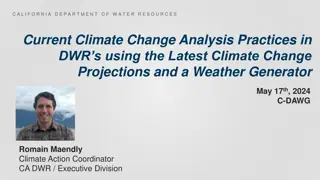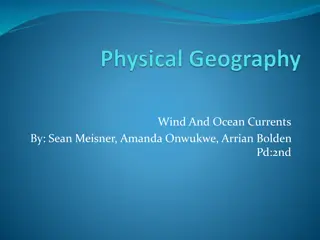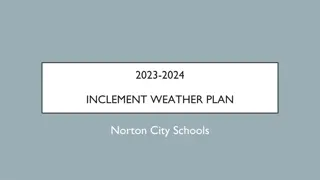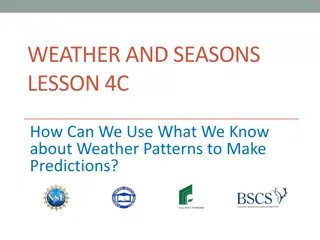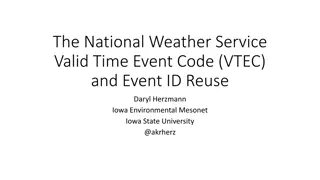Understanding Weather and Climate Factors
Weather and climate are essential aspects of understanding the Earth's atmosphere. Weather refers to short-term atmospheric conditions, while climate represents long-term averages over 30 years. Factors influencing climate include distance from the equator, altitude, proximity to the sea, wind directions, humidity, and rainfall. Land and sea breezes play roles in regional climate patterns, while heat zones like the torrid, temperate, and frigid zones highlight the varying temperature characteristics across the Earth. Explore these elements to gain insights into the dynamic nature of weather and climate.
Download Presentation

Please find below an Image/Link to download the presentation.
The content on the website is provided AS IS for your information and personal use only. It may not be sold, licensed, or shared on other websites without obtaining consent from the author. Download presentation by click this link. If you encounter any issues during the download, it is possible that the publisher has removed the file from their server.
E N D
Presentation Transcript
5.WEATHER AND CLIMATE CONTENTS: 1.WEATHER AND CLIMATE 2.FACTORS INFLUENCING CLIMATE 3.HEAT ZONES 2
WEATHER AND CLIMATE Weather is the condition of the atmosphere at a particular place over a short period of time. Climate is the long-term average of weather, typically averaged over a period of 30 years. 3 Chapter 5/Social Dept/Karunambigai/Sns Academy
FACTORS INFLUENCING THE CLIMATE 1.DISTANCE FROM THE EQUATOR. 2.HEIGHT ABOVE THE SEA LEVEL.(ALTITUDE) 3.DISTANCE FROM THE SEA. 4.DIRECTIONS OF WINDS. 5.HUMUDITY AND RAINFALL. 4 CHAPTER 5/KARUNAMBIGAI/SOCIAL DEPT/SNS ACADEMY
Land breeze Land breeze blows during the night from land to sea and the land becomes cooler faster than the sea. The air above the sea becomes less dense (i.e. warmer) and rises. The cooler air from the land moves in to take its place. Chapter 4/social/karunambigai/Sns Academy 5
SEA BREEZE Sea breeze: Sea breeze blows during the day and the land heats up faster than the sea. The air on land becomes less dense (i.e.warmer) and rises so the cooler air over the sea which is denser(cooler) flows in to take the place of the warm air, causing a sea breeze. Sea breeze: Sea breeze blows during the day and the land heats up faster than the sea. The air on land becomes less dense (i.e.warmer) and rises so the cooler air over the sea which is denser(cooler) flows in to take the place of the warm air, causing a sea breeze. 6
HEAT ZONES 1.TORRID ZONE 2.TEMPERATE ZONE 3.FRIGID ZONE 7
TORRID ZONE The torrid zone refers to the area of the earth between the Tropic of Cancer and the Tropic of Capricorn. Geographically, the torrid zone is defined by 23.5 degrees north latitude and 23.5 degrees south latitude. Torrid Zone is the hottest because it is very close to the equator. At this zone, the sun is very close to the earth and it receives the maximum heat from the sun. 8
TEMPERATE ZONE In geography, the temperate or tepid climates of Earth occur in the middle latitudes, which span between the tropics and the polar regions of Earth. In most climate classifications, temperate climates refer to the climate zone between 35 and 50 north and south latitudes Average yearly temperatures in these regions are not extreme, not burning hot nor freezing cold. Temperate means moderate. 9
FRIGID ZONE Frigid Zone is the area between the Arctic Circle and the North Pole or between the Antarctic Circle and the South Pole. This climate is characterized by a long season of severe winter and even the summer season is cold. The precipitation is very low, generally below 30 cm. CHAPTER 5/KARUNAMBIGAI/SOCIAL DEPT/SNS ACADEMY 10



